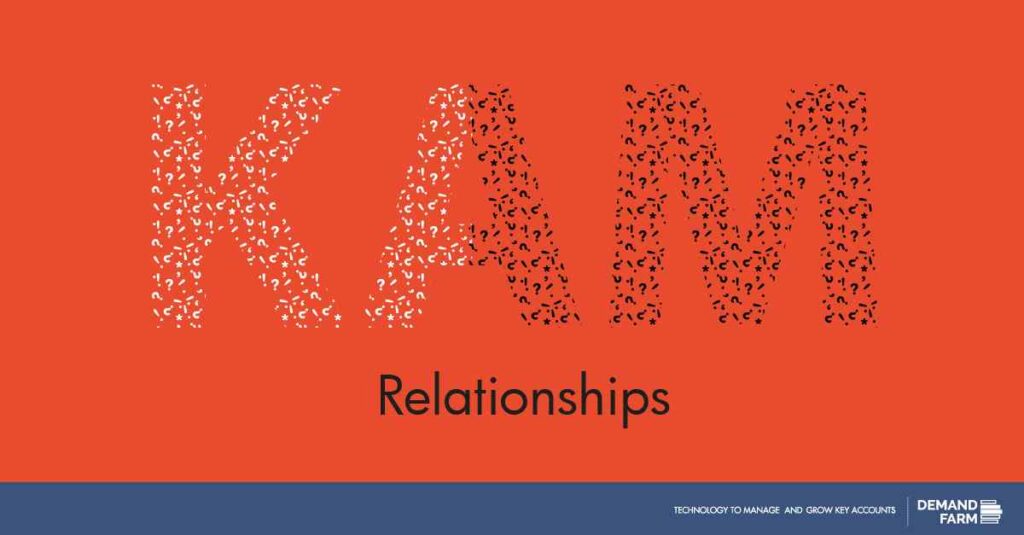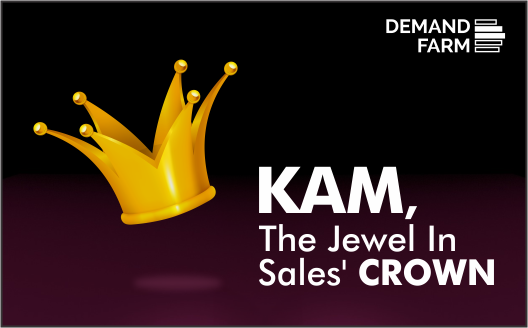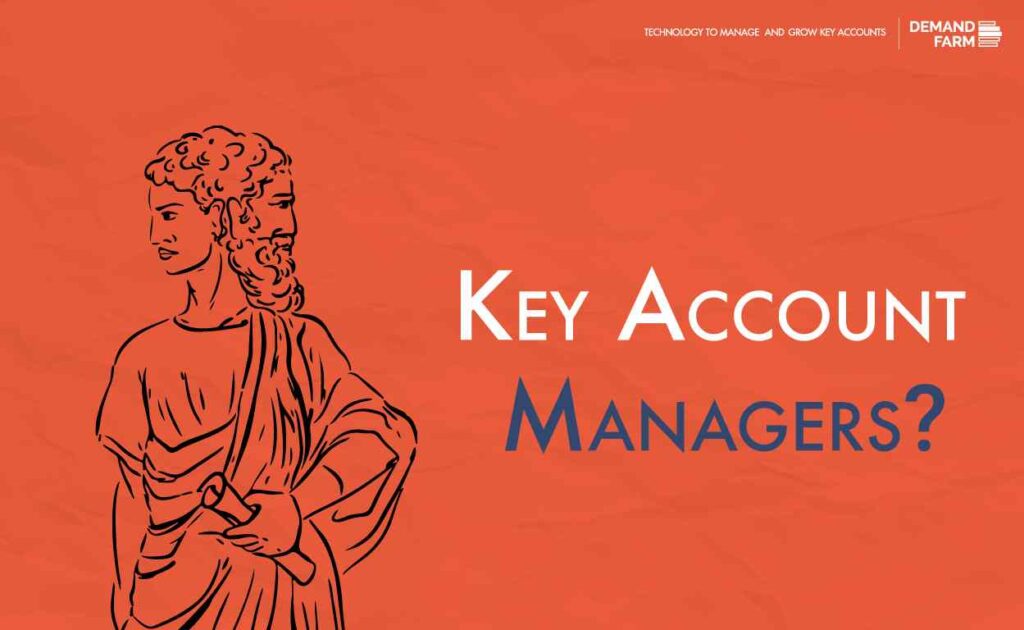Key Account Management Vs. Regular Account Management

The one common mistake many organizations, both small and big tend to make and repeat, is to treat all their accounts the same. It is never too late, however, to correct the situation and start looking at your account types more closely. You will notice, there is a key difference in the account types, organizations like yours, have in their portfolio. Largely, accounts can be divided into two key categories- the Key Accounts and the Regular Accounts. Each of these two categories needs a different management style, system, and people. An Account Management process is required to manage Key Accounts, which require more nurturing and attention than normal accounts. Let’s look at why these two categories are different and to be treated differently. What is Key Account Management? Key Account Management is a strategic approach to managing and nurturing business relationships with the most important customers of an organization. These key accounts are typically a small group of customers who contribute significantly to the company’s revenue and long-term success. The purpose of Key Account Management is to maximize the value of these key customer relationships by providing personalized and tailored solutions that meet their specific needs. This helps in building strong, sustainable partnerships that can lead to increased sales, higher profits, and better customer retention. Furthermore, Key Account Management is not a one-time process but an ongoing one. It requires continuous nurturing and adaptation to changing market dynamics, customer needs, and business goals. What is Regular sales? Regular sales is a common criteria of selling products or services that has been used for many years. It involves the direct interaction between sellers and customers, often through face-to-face meetings, phone calls, or cold calls. Traditional sales also rely heavily on advertising and promotional activities to reach potential customers. Key account management vs regular account management : Key differences High-Value and High-Volume Your Key Accounts are the high-value accounts. So, the number of projects or tasks or transactions you win from each of these accounts may be small, but the value of each of these transactions is big. Whereas your regular accounts, maybe many in number, and each may give you, a large number of projects or transactions, but the value from each is smaller. Such accounts are therefore popular for their volumes. What is important is to remember that both types of accounts are important to your business, only that, you need to manage both differently. Customer-centric and Transaction-centric Accounts The high-value accounts are your customer-centric account, that is, the focus is on building a long-lasting relationship with the customer. These accounts usually have a longer buying lifecycle and hence, repeat orders may be fewer; but the value for each of these orders makes up for everything. The customer becomes the key here and more so, your relationship mapping with him. Trust is never easily won and needs to be maintained and built upon. These high-value accounts are important to your overall business plan. The other type of accounts is the transaction-centric accounts, where each transaction is important. Here, the transaction is not high in value, but the number of transactions is more important. Repeat business takes center-stage and that is the sales team’s objective. For effective key account management, your brief to the sales team should be to nurture the relationship of your KAs (Key Accounts) and in the transaction-centric accounts, your brief should be to increase the value of each transaction. Personalized and Automated Accounts Automation is the name of the game today and helps your transaction-centric accounts when it comes to being regularly updated about their purchases, stocks available, lead time and service issues if any. These are RAs (Regular Accounts) who have established a certain sense of comfort and rhythm for you and with you and can be managed through an automated system with minimal personal interaction. On the other hand, are your KAs who need personal and personalized interaction at all times and at every stage of your journey together. They should also be on your automated system but only so long as it helps them to function uninterrupted in matters that are more operational. Key Accounts need to be handled with TLC of the professional kind; you need to invest in the relationship by meeting them personally, understanding their needs and exceeding their expectations. Key Accounts need frequent and regular personal attention; if you take this as a non-negotiable in your business plan, you will go far with your KAs. F2F and F2A Accounts Face2Face or F2F is the nature of the interaction with your KAs and F2A (Face to Automated System) is the nature of your RAs. The main objective of your KAs needs to be personal and interactive in almost real-time; whereas the main objective for your RAs needs to be largely data-based. The course of your interaction with your RAs will be decided on the numbers that the automated system throws up, but your KAs will have to be more qualitative in nature. KAs is about managing relationships and RAs are about managing numbers. 80-20 Accounts The famous management rule applies in this case too, where 80 % of your profit will come from 20% of your accounts, which are your KAs and 20% of your profit will come from 80% of your accounts, your RAs. What resources to invest and how and where, are the key questions you have to handle. Automated systems will work best for the 80% of your accounts – RAs, whereas, you can safely invest and focus your personal time on 20% of your KAs. Knowing and serving these two different account types is the key to maximizing the potential of your sales force. It will pay to look at specialized Key Account Management Softwares to help you mine your Key Accounts and enrich your relationship for the long term. Read our blog on Strategic Account Management or Explore the complete guide to Cross-selling and Up-selling to identify unexplored opportunities for your business as well as your clients’ business and grow better in 2021. The Importance of
The 5 Skills Every Kickass Key Account Manager Needs in 2025

We’ve gone over the fact that 80% of your key account revenue comes from 20% of your accounts. Thus, the key account manager who manages this 20 % of accounts plays a key role in the ongoing success of your business. He/She needs to nurture your company’s most valuable customers and build a long-term relationship with them, not just as salespeople but as trusted advisors. This key account manager can have such a huge impact on the fortune of a company is in a very influential position. The responsibilities and expectations may be many, but the time on their hands is very less and hence certain skills are needed to do the job well. Guide: Career progression for key account manager Here are the top 5 Skills that every Key account manager Professional should have to do his job amazingly: #1. Effective Communicator Key Account Managers are in a unique position where they constantly interact with people within the client organization who have extremely powerful roles and positions. Communicating with such high flying corporate executives is not easy. They need training on the specific key account they are handling. Key Account Managers must strive to constantly keep communication flowing to establish themselves as trusted advisors. The client touchpoints should feel that they can reach out to their account managers with any question/concern and that they will receive a helpful and thoughtful response. In order to be a successful key account manager, he/she should be indispensable to the client in every way. It is truly an art to keep clients engaged without being intrusive. #2. Proactive Key Account Management The biggest mistake that Key Account Managers do is thinking that they don’t need to rock the boat too much. They believe that their job is just wine and dine clients and build a relationship mapping through this. A Key Account Manager must proactively glean insights from the customers about how the product model is functioning for them, if there are gaps in product fitment and if there is any reason for them to be unhappy. This description can allow him/her to proactively put out key account management fires, even before they arise. This information can be used for new product development to address any gaping need, as spoken about in this blog. #3. Empathizing with Customers A Key Account Manager must, of course, have research and analytical bend of mind where he/she understands the client’s goals and expectations deeply, but it is also important to understand any problems that they may be facing. Key account managers must collaborate with customers to create a plan of action to work towards business goals. If the KAMs follow through with those plans while adjusting for market conditions they stand to demonstrate the real value of their company. A true Key Account Manager will consistently help clients achieve their end goals while remaining in a fiduciary position. When a client can show its senior management that a Key Account Manager positively impacted their bottom line by putting their blood, sweat, and tears in there is bound to be a lasting collaboration. #4. Challenging The Key Account to Use Optimal Strategies Look for opportunities to educate your key accounts, or even challenge them with a new way of thinking when appropriate. If they’re asking how to do something a certain way, and you know of a better way, use that chance to educate them for everyone’s good. When a key account asks you how to do something, seek to understand why they want to do that. By understanding their motives and reasons, you’ll be able to recommend an alternative course of action. Your job as a key account manager isn’t to make friends with your key account, and not even necessary to “satisfy” them. Your primary job is to push your key account, challenge them, and get them to think, in order to make them generate more revenue. #5. Becoming a disruptive growth key account manager Nevermore has there been a better time for key account managers to reposition themselves by taking charge of the disruptive growth agenda. Such initiatives by managers are often the most creative and have the biggest revenue potential. Key account managers that want to do their job well and reach their potential and move into a disruptive growth role in 2024 can do so by: Breaking the barrier: The manager that can best articulate a disruptive growth strategy will be king of account management. As most companies look to grow, key account managers should be the ones to step forward to create the platforms that will catapult their key accounts forward into new business possibilities. Data Monetization: While traditional key account management activities continue to be important, more focus can be allowed to drive disruptive growth initiatives that present data visualization and analysis. New tools and initiatives in mining data can help the key account managers to take necessary actions towards monetizing it. Competition analysis: The landscape of competitors is always changing. Every day new competitors enter the market. It is necessary to watch out for innovations your competitors are bringing up to stay aligned with the trends in the industry. Only a few key account managers believe defending their key accounts against new competitors that have not traditionally been part of their industry is a priority to their key accounts today. Key accounts can avoid being disrupted, but only if they can see what’s coming. As a Key account manager, you are now at an inflection point in 2024. You have a clear opportunity to step up to the plan of growth and expansion in 2024. So far, most have missed the opportunity, resulting in others being in front of the line for the role. Currently, the plan is ripe for the taking, but opportunities such as this one have a shelf life. With swift, sure action, key account managers can capitalize on their window of white space opportunity.
Is An Account Manager – Robot? Iron Man? Or Superman?

The approach to problem-solving was superbly explained to me by Dhiraj Rajaram of Mu Sigma. I loved the simplicity of the framework & its analogy. The implication in the business process and problem-solving is profound. I kept revisiting this framework for the Key Account Management process. So what persona do you want your Account Managers to have? Robot: Key Account Management is not that simple. One cannot ‘automate’ the whole process and have Robots run the process. There is a uniqueness to every b2b company in terms of what value they add to their strategic accounts. Their uniqueness to each account of the same b2b company. So unless you sell something that is completely commoditized, you cannot make your Account Managers into Robots. Superman: You would want all your Account Managers to be Supermen of course. That’s not going to happen. Few could be, that too for some time and not all the time. Training all your Account Managers to be Supermen is not scalable or sustainable. Iron Man: I like him. He is a human and if provided with the right tech and account planning tools can do amazing things. A reasonably intelligent and passionate account team provided with tech & tools (read DemandFarm). They return amazing results. This is scalable & sustainable. At DemandFarm we automate the repetitive & simpler tasks of an Account Manager (Robot). We also provide frameworks that can be configured to suit your company’s Strategic Account Management process (Iron Man). We leave the ‘human’ in your Account Manager to do what only humans can do (Superman). That’s why 5000+ Account Managers love using DemandFarm’s key account management software to manage and grow their accounts. Let us show you how we do it.
Time to Question key account management relationships

Key account management relationships So you are in a key account management review meeting, going over the year’s plan with the global accounts team and the business heads. During the meeting, it emerges that your key account planning could fall short this year. As a senior key account manager, you present the reasons – Team Churn in the Key Accounts, followed by Organization restructuring in the accounts. All present go into a ‘thinking’ mode, only to be interrupted by the CEO, who steps into the meeting to exchange pleasantries. “Hey, what’s going on?” You say, “Boss, unexpected organization development issues at my account could jeopardize this year’s goals. “Pop came the question, only CEOs ask.” OK. So how are we doing in terms of our relationships with this account? And how does this relationship scale with time and corporate actions?” The question didn’t surprise. For you, yourself have been looking for account planning solutions since the time people issues have been surfacing at the key account. Key Account Management Relationships are the core As we see in the example above, key account managers can make significant gains by taking good care of their relationships at the key accounts. Surprisingly, it does not get the necessary attention until confronted by a dire situation. It is ironic because sound strategic account management is supposed to anticipate such issues and propose proactive remedial measures. Gaps, when discovered, could be both – strategic and transactional. Strategic Gaps Such gaps are identified because the key account management strategy missed considering such factors in the overall strategy. It does happen that while collaborating with the key account for value creation, teams from the key account side tend to discount disruptions that could emerge from their side. It is natural for key accounts to be more cautious about their suppliers. An established Key account management process driven using systems and structure can very well address such limitations. At times, the hunting nature of the business at supplier organizations also tends to impact the focus on relationships within key accounts. Transactional Gaps These are mostly operational issues that are discovered only when they happen. The reasons could range from incorrectly updating the CRM to not documenting minutes from the last meeting. Identifying, addressing and testing these gaps will enable key account management driven businesses to leverage relationships better. Eventually, this could help better value creation and confront challenges when they crop up. Questions to Ask If you are an account planning driven business that has witnessed situations where depreciation in relationships (for reasons whatsoever) has compromised business goals, the following questions are a good place to start. Who are the people who count in the Key Account? Status – Can you connect each name and role back to the existing client relationship? Budget – What budgets does each person at the key account control? Decision Makers – What specific areas of the decision-making process does each person participate in? Power Equation – Who is a champion, gatekeeper, influencer, detractor orally? Influence – What internal stakeholders or networks can be activated to develop or nurture the right relationships? What are the relationship dynamics amongst the team members at the Key Accounts? Capturing the who’s who in the key accounts is ok. It is indispensable to push further. Key account management teams don’t stop at that. They go further and capture the intensity of the relationships that exist within the key account teams. Ask yourself – Are you able to bring a real-time, flexible, and responsive approach to managing multiple stakeholders? How to map and track people and their ever-shifting connections, motivations, dispensations, and affinities? Are you set up to have custom-made contact plans that can evolve with the relationship dynamics? Can these changes be captured formally and reflect throughout the system to all internal stakeholders? Relationship Context? Actionable insights from the above relationships require the presence of context. Context would help set the agenda at all times. Big Picture – Can you connect the roles and titles to the bigger picture of the account relationship? Are you set up to create value in the customer’s context and not just in your own comfort zone? Quick View – Do you have an easy and convenient way to view these networks of context and spot opportunities for value creation? Institutionalizing Relationships? Key account relationships should outlive the KAMs and all the members that constitute the strategic account planning teams. Therefore, it is critical to building accounts and people’s knowledge into the system so all internal stakeholders are tuned in and can do their part seamlessly. The key questions to ask are as under. Time – How much time and effort is spent on making – in real-time, and as productively as possible – the right information and context available to internal stakeholders? Institutionalising – How safe you are from attrition and losing control of valuable relationships because of people’s changes? Process – How easy is it for you to capture the right information into the system as a part of the process What can technology do for this web of Relationships? Technology holds the power to automate many manual tasks. Thus, freeing up time the KAMs time to ‘think’. Manual management of vital relationships with a spreadsheet or notebook is not just inefficient, it’s also a risk. It only makes key account management vulnerable. Are any of your relationships being managed manually? Do you then face the following limitations? Missed Opportunities – Are you missing opportunities due to a lack of visibility or ability to connect people to the business context? Single View – Can your tool help connect the dots across all the variables and show both – the big picture and the micro-picture, based on the need? How many of these 15+ questions on account relationships can your current key account management strategy answer with confidence? Should there be more questions that need to be addressed? Should we also look beyond relationships into the realm of product/services, market,
Key Account Management, The Jewel in Sales’ Crown

Sales is a critical function in any organization and have always been able to attract internal resources, both human and capital. Key Account Management began as an add-on to sales or a different way to structure departments and assign responsibilities. Though it received plenty of account management focus, there were few specialized human resources and even less capital or technological resources. Only when the number of key account managers reached a tipping point did firms felt the technology-pinch, unable to support collaboration, consolidation or standardization of methodology. But the times changed and with them the behavior of the Key Account Manager. So why have companies been willing to spend resources on CRM, sales training, etcetera but not on KAM? It could be because top-line results are credited to front-line sales while key account managers slog behind the scenes. Top management commitment is important, but it is not enough to create a successful KAM program. Without adequate resources can a company create the foundation on which to build a robust KAM system? In our experience, a three-pronged approach to KAM yields the best results. 1. Choosing the right Key Account Managers: Your best salesperson is not necessarily the best key account manager. Along with influencing skills, they also need collaborative and general management skills, the ability to interact with internal and external stakeholders, to identify problems and design appropriate solutions. It definitely helps to have a manager who can take a long-term perspective on building relationships. While you may choose a person for the role based on some inherent traits and skills, it is also important to invest in training key account managers to help them achieve their full potential. 2. Choosing the right technology: Just as sales managers are enabled with CRM, key account managers need to be enabled with KAM-specific technology. Key Account Management software draws data from a CRM like Salesforce, thereby avoiding data entry and duplication. It supports collaboration across multiple departments and executives at different hierarchical levels. It helps create a relationship matrix and identifies white space or white space opportunities. A standardized process and unified view help improve performance. 3. Measuring and monitoring achievements: Here is a truism that is often ignored: Sales targets and key account goals are not the same. If you want a key account manager to develop a long-term perspective, you have to create long-term goals and pick quantifiable criteria that measure the health of a key account. Account management tools are a great asset as it gives you a multi-dimensional view of the key account; revenue, profitability, deals in the pipeline, relationship strength, untapped potential, share of customer’s purchase and more. Each parameter is measured and monitored individually, followed by analytics to calculate the overall health of a key account. The first CRM software, introduced in the nineteen-eighties, was a simple digital Rolodex! It took several decades and massive technological innovation before CRM became a necessity, not an option or luxury for sales professionals. However in today’s technologically advanced world, decades have shrunk into years and companies that have not invested in KAM technology are not able to exploit, or even recognize, the potential of their key accounts. Your budget should no longer be a debate about CRM or KAM. If you want to maximize growth and tap the potential of your key accounts you need to enable your key account managers by investing in KAM technology. Stop treating KAM as a stepchild. In today’s customer-focused, solution-oriented market, KAM is the jewel in sales’ crown.
Will Real Time Reporting for KAM Help Sales Ops Breathe Easy?

Real-Time Reporting won’t just help; it could power Key Account Management model to success. A veritable game-changer, possibly. The DemandFarm Blog has consistently argued how Key Accounts are latent revenue drivers. The hourglass metaphor neatly sums up the growth potential Key Accounts hold. Unfortunately, these opportunities are not evident to the extent that they become compelling. Thus, most of the time, the Key Account Management strategy is fraught with a ‘business as usual’ approach. The absence of real-time reporting plays a little role in accentuating this problem. The sales operations team entrusted with the reporting function recognizes this challenge. But what can they do? Reporting on Key Accounts is saddled with complexity. On one hand, we have the overwhelming business of the Key Account and on the other, the way organizations manage Key Accounts internally – endless Excel files sitting at various locations, PPTs whose templates keep changing, not to forget the occasional paper memos and thesis emails, and ultimately some closed-door meetings that may not have been minuted. The sales operations team has its task cut out. Why anytime reporting? Because, why should it be any other way? Ok, that was the short answer. The longer one starts with the status quo and ends with transparency. Diagnostic Status QuoToday, Sales Ops teams prepare reports by collecting data from various sources. Some of the data sources are within their control and mostly a click away. However, some, including financial metrics and sales team activities, require coordination and repeated email requests. This adds ‘point of failures’ to the workflow. Even if things work out on time, manual reconciliation issues, omission commission errors and ‘Acts of Man’, make reporting one BIG job. What this means is that the reporting process takes a couple of weeks or more? This lead time runs the risk of depreciating the value of any reporting insight if derived. What may be needed is a real-time, insight-driven report that Spurs necessary and relevant business action. Not a diagnostic that just presents what happened. Transparency to the C-Suite Key Accounts are core to an organization’s strategic plan. Their performance gets attention not just from the Head of Sales, but also from the CEO. The C-Suite, especially, is well-positioned to make a material difference to Key Accounts, by virtue of existing relationships and scale. The current diagnostic approach to reporting compromises the leveraging power of C-Suite in 3 ways. Reactive: The C-Suite has a dependency on reporting teams for insights. Thus, their reactive response. Additionally, review meetings become clarification/ correctional sessions instead of collaborative engagements designed to move forward. Optimistic Dressing: A manual approach to reporting, inadvertently, encourages optimism, and to a great extent when it comes to C-Suite reporting. How do we correct this? The big picture: the C-Suite gets reports from various Key Account teams at various times and may miss out on the BIG PICTURE of multiple Key Accounts and what that may mean to the overall organizational strategy or health. It also helps track several Annual Plans and how they are faring compared to the projections. A real-time accessible report can make the C-Suite an integral team member of the Key Account Management process. Sales Ops leaders realize this potential of any time reporting but have their own problem of plenty. The Tough life of Sales Ops An article from Harvard Business Review cleverly presents the hardships of Sales Ops by jotting down some job descriptions (JD) for the role of Sales Operations. Here is what one of the JD looked like: Strategy Contribute to the 1- and 3-year business vision as a member of the executive leadership team. Evaluate sales force strategies, plans, goals, and objectives. Contribute expertise to optimize sales force and territory sizing, structuring, and alignment. Operations Oversee sales performance analyses and reporting, territory alignment, and customer profiling and targeting activities. Administer quarterly sales incentive compensation plans and the goal-setting process. Manage sales force automation and CRM systems and processes. Provide data, analyses, modeling, and reporting to support sales force quarterly business reviews. This 85-word excerpt from a JD had just ‘one’ word for ‘reporting’. Beat that. The good folks at SalesLoft in one of their eBooks dedicated to sales operations leaders broke down this role into three. Process Data, and Implementation As you guessed correctly, reporting falls under Data and is just one of the functions executed by Sales Ops. So without automation, there is a good chance of reporting becoming a distraction. In addition to this, Sales Ops are also burdened with technology and account planning tools. These days, the best sales teams are empowered by technology solutions, tools, and data. These technology solutions and tools have enabled many organizations to create sales force effectiveness and sales growth. This flow towards technology has indeed made Sales Operations a vital part of the sales by uniquely positioning them to leverage data and technology. All this requires Sales Ops to put strategic time into sales enablement, warranting the need for automated reporting. After all, we are talking about expensive salesman hours. KAM Technology to the Rescue A Key Account Management tool can surely help organize data better and enables sales leaders and indeed all stakeholders to have access to reports and data anywhere anytime. Leverage Existing Data – Leverage existing CRM data to populate analytics rather than depending on the managers, SDRs, and KAMs to fill it out for you. Collate all the data into a single format and store it in a single place so everybody can access and interpret it consistently and in real-time. The platform for Collaboration – It can provide a platform for collaboration between the many stakeholders involved in managing and growing the most strategic customers by making reports and actions shareable and interactive. Insights Like Never Before – Deliver the right customer-centric insights for clarity and action. The landscape, whitespace, opportunities, relationship ‘type’, ‘health’, and ‘attractiveness’ everything to make strategic decisions about key accounts. KAM Technology empowers Sales Ops teams to service and drive business focused
How can KAM Sales help your Organization?
What is Key Account Management (KAM) Sales? Key Account Management, or KAM as it is called, is usually not a transactional activity. It involves larger stakes and requires a buy-in from all stakeholders that are involved. After all, KAM Sales is not a single activity we are talking about, but a whole relationship that we are putting on the table. Essentially KAM Sales is a much wider term than sales will ever be. Typically, there are certain challenges that arise with it every now and then, such as, short-term interest wins over long-term goals. Secondly, it can be overpromising. This often leads to mishaps and even fatalities of Key Accounts, especially in cases of overpromising and under-delivering. When everyone at the organizational level is not looped in, there could be a rise in confusion, chaos, and inefficiencies. But all these probable gaps can be taken care of if certain things are seen to. Identify the Key Accounts for KAM Sales Every Account can’t be categorized under Key Account Sales. Identifying key accounts is crucial. Strategic and complex organizations, which are inclined to participate in collaborating and co-creating value should be adopted as Key Accounts. These Key Account Sales should have potential and considerable long-term possibilities to ensure maximized lifetime value. Conduct a historical study of KAM Sales data Key Account Management Sales does not mean jumping into an engagement that may turn out to be lopsided, one way or the other. Once the potential is identified, it pays to study past data to understand the dynamics of the account in areas such as product, pricing, service- gaps if any and growth potential. Based on this, a mutually beneficial contract can be drawn. Find and train the right people for KAM Sales positions Key Account Managers may not be your best salespeople and vice versa. Sales Acceleration needs a unique skill set in the key account management scenario. It is more of an overarching function like that of a Project Manager. This is a CFT, a cross-functional team that will come from top to bottom in the hierarchy and left to right, across functions. It is integral to have the right team who knows what the stakes are and what they have to do for their accounts to grow exponentially. Track, Measure and Build The true measure of a Key Account is in the lifetime value of that customer to your company and the value-added to the customer’s bottom line. This is what one needs to track and measure regularly and build a Key Account Management Sales program that evolves with the customer’s or rather, the Key Account’s evolving needs. The Sales team overseeing the Key Accounts should comprise of people who can identify customers that can be moved up the KAM status. The alignment between marketing and sales will define the success of your KAM technology adoption program. It is all about collaboration and co-creating success. This is how we feel KAM Sales can be a fruitful endeavor for any organization, please reach out if you have any thoughts to share on this topic! I’d love to hear from any reader who’s been inspired by this blog.
Can Artificial Intelligence and Machine Learning impact KAM?

My marketing team often insists that I write about Key Account Management. Until now, I often thought that since there is already so much written about it, how could I possibly throw more light on the subject with the aim of ‘adding more value’ to it at the start of the new year. So, here’s what I thought I’d do; I thought it better to summarize all that I have written in the past and open up a new discussion on whether or not (and most importantly, how) Artificial Intelligence (AI) and Machine Language (ML) can be used for Account Management. May I just mention here that I don’t know the answer to the above! Not yet at least! But here’s what can help: I had once written about how to segment key accounts. It is essential to understand, at least once a year, which of your accounts are your ‘strategic partners’ and in which accounts you are a ‘tactical vendor’. Or somewhere in between-Cooperative/Interdependent relations with clients. This exercise need not be complex or time-consuming. Another time, I had elaborated on white space analysis and metrics to track for Key Accounts in a two-part blog. We can identify areas of growth in an account by building an account landscape that consists of the ‘Buying Centers-Offerings’ matrix. The account growth if analyzed separately in terms of ‘farming’ and ‘mining’ growth will give a real picture of where the growth is coming from and future possibilities. With the growing use of technologies like AI and ML, my mind is often occupied with assessing its true value on Key Account Management. Does it support KAM just as well as it does marketing, sales, and other associated business activities? Honestly, I still don’t know the answer. Even as a participating industry professional I too am often confused with ABM/ABS/ABE claiming Key Account Management space with AI/ML. For those uninitiated, ABM/S/E stands for Account-Based Marketing/Sales/Everything. While I do agree that AI/ML algorithms can be built to identify the right accounts through intent/ searches/ announcement these accounts can also be targeted effectively using display advertising based on role/function and their watering hole (media). All the AB(X)s still only focus on acquiring an account in the B2B marketing context. That is not Key Account Management. The fact is, KAM is what you do after acquiring the strategic account. Some of the most critical elements of Key Account Management include: Understanding the customer’s business deeply. How they are structured, which business units are growing rapidly, geography-wise spread, what are the strategic initiatives and management changes – are some of the areas to study. Creating a solution using my products/services to create more value for the customer’s business challenges. Understanding which of our current engagements could grow as well as which are at risk and what are the new doors to open. Collaborating and building relationships with people in the customer organization as well as internally within my company. Making account plans with the above information leading to revenue goals, specific actions, and timelines. All these listed elements are human processes that require a fair amount of cognitive thinking. Every account for a key account manager will have unique situations requiring tailor-made solutions, approaches, or strategies. I don’t see a possibility of it ‘trending’ to make any regressive analysis here. The key takeaway is that – any good account manager will use heuristics rather than a deduction to make decisions. The best I have achieved is to create frameworks, (not processes!) for strategic account management. A key account manager is constantly asking questions to herself and her collaborators. Whereas, AI/ML is about answering questions. That is where I am stuck and I am hoping 2021 will give me some clarity on this. You can explore the innovations in KAM Technology in recent years by reading our Ebook.
Key Account Management (KAM) – Past, Present and Future
KAM Definition – Key Account Management is a strategic approach distinguishable from account management or key account selling and should be used to ensure the long-term development and retention of strategic customers. The acronym used by professionals in this industry is KAM. Past What the customer thinks he is buying, what he considers “value” is decisive – it determines what a business is, what it produces and whether it will prosper’ – Peter Drucker Origin of KAM The origin of KAM lies way back in the era of Peter Drucker. A learned man, he understood the concept of customer dynamics and forecasted the change during his time. It was then that organizations realized the concept of soft selling, and started focusing on relationship mapping with their customers. According to research, companies that focused on long-term relationships with customers generated more profits than the companies that focused on short-term customer goals. Hence maintaining long-term happy relationships with customers became a ritual with practices like contact management, behavior-based loyalty and reward programs, etc. Organizations began to develop separate teams of ‘Account Managers’ that were solely responsible for looking after and managing the company’s larger and more valuable Accounts. Special teams were even developed to manage ‘high potential’ Accounts that needed to be nurtured and developed over time for a potentially rewarding relationship. Pareto Principle As the markets evolved, customer – buyer relationships evolved. The Pareto Principle was a defining observation – 80% of revenues came from 20% of Accounts or Customers. Those Accounts were later referred to as ‘Key Accounts’. Organizations started focusing on resources primarily on Key Accounts. However, Strategic Account Management was still an underserved opportunity. The people responsible for managing Key Accounts were in reality ‘Key Account sellers’, managing opportunities rather than the relationship. Present It is only in the recent few years when companies have started realizing that when buyers and sellers share a collaborative, interdependent relation, productivity increases in the long term. Looking at the current market scenario, there seems to be a rise in overall KAM technology adoption and awareness across industries globally, but if we talk about the United States, the overall Google searches for KAM have remained constant over the past 5 years time. In the graph from Google Trends below, you can see the number of searches for Key Account Management in the United States over the period of the last 5 years. Well! A possible reason for the stagnancy could be a lack of perception about KAM as a dynamic or trendsetting function in the organization. Key Account Managers are a bit like unsung heroes, chipping away at complex relationships, away from the limelight. Needless to say, they have almost the same pressure as the regular Sales team to meet their quotas, but because successes are not so fast or visible, they tend not to be top of mind when it comes to the development of enablement or automation tools like CRM. Automation is generally some modified version of CRM because the focus tends to remain on the Key Account Managers individual relationship building skills. Methodologies for KAM Sales tend to be homemade, and core processes are not systematic or consistent across the organization. However, like every other field, technology is driving the world and KAM can’t escape for long. Key Accounts are getting increasingly complex, dynamic, global and networked. There is a genuine need to be able to automate and institutionalize key processes, reduce a person’s dependence, enable the people who drive KAM, manage data and analytics and of course track customer goals and opportunities in a more structured way. Associations like SAMA are trying to spread awareness globally about Strategic Account Management & emerging technologies through their efforts and events. We are looking forward to seeing a lot more KAM tech in Dreamforce’16 coming up this October. However, the traditional mindset that considers KAM an ‘art’ tends to question the scope of technology. We say it’s time for organizations to start asking- can technology transform the way we manage and grow our Key Accounts? It’s a question that we just can’t afford to ignore anymore. Future The future of KAM is about not just increasing productivity in the long term but about creating value for all shareholders in the ecosystem. With increasing complexity, it’s imperative to look for solutions that operate at the cross-section of the art and science of Key Account Management and help take execution to the next level. On the positive side, some industries are leading the charge for KAM, with Google trends showing a positive increase for KAM searches over past 12 years across Banking, Health and Business and Industrial areas. These are also the early adopters for KAM technology. The 90s was the year of CRM; 20s can be the year of KAM technology. What do you think? We’d love to hear your views on the past, present, and future Key Account Management, and especially on technology to transform Key account management. Write to me and we will share the best ones with all our readers on this blog next month!
Janus-Faced Key Account Managers?

Key account managers share a love-hate relationship with key account management methodologies. Ironic, isn’t it?Often, I have heard KAM purists say that the best Key Account Management is to understand customer’s strategic goals and find ways of helping them achieve that. The Key account managers aren’t amused and retort, ‘You know what is the strategic goal of my customer? They want to rationalize the number of vendors to half this year. The remaining vendors have to find ways of saving at least 25% of the price. Another classical KAM theory advice is, ‘You must “co-create” value with customers. An Account Manager from a plastic molding company heard this at a conference. *Later during coffee break* “Oh yeah ‘co-create’ b**l sh*t.” One of his customers wants to convert many engine parts from metal to plastic. But refused to spend jointly on developing the prototype and mold. The best he could get was supplying fixed volumes for the first year if prototyping is successful. He knows that in the second year, he has to compete for the price with other vendors. So much for ‘co-creation’. It is foolish to broad-brush key account management. KAM in different industries like enterprise SaaS, plastic molding, IT Services, and commodity steel will be different. I think we should begin by making KAM methodologies simpler. The theorists and coaches have gone too deep and far to differentiate one methodology from the other. Therefore many are utopian and not practical anymore. It partially explains why key account managers hate to follow them to the ‘T’. Utopian Key Account Management For example, other days I came across a relationship map template where every customer contact was to be tagged with 5 parameters. Political Role Personality Type Your Relationship Coverage. Each of these parameters has 5+ options to choose from. This is over and above hygiene attributes – name, title, department, location, reports to, reporters, budget controlled, opportunities….. Is it realistic to get this data for even 3 dozen contacts in an account? Even if you get it who will document this? Even if one does, who will update this data every quarter?Come on, be a sport. This is an example of only ‘Contact Relationship’. These coaches/ theorists have complicated and made unrealistic all other elements of KAM like Account Planning templates and Account Segmentation. On the other extreme, KAM practitioners (Account Managers) have left it to ‘Heroes’ or serendipity. Basically relying on that individual with good relationships and domain knowledge to manage the account. Or leave it to chance – being there at the right time, with the right people, and with a solution that fits NOW. Ideally, strategic account management stakeholders should strive to strike a balance. Account manager comfort has to be balanced with account priorities with account planning being right there at the top.Perhaps, the time has come for us to go back to KISS for KAM. Keep It Simple, Stupid. Here is how to keep it simple. You just have to read my strategic account management process blog.


